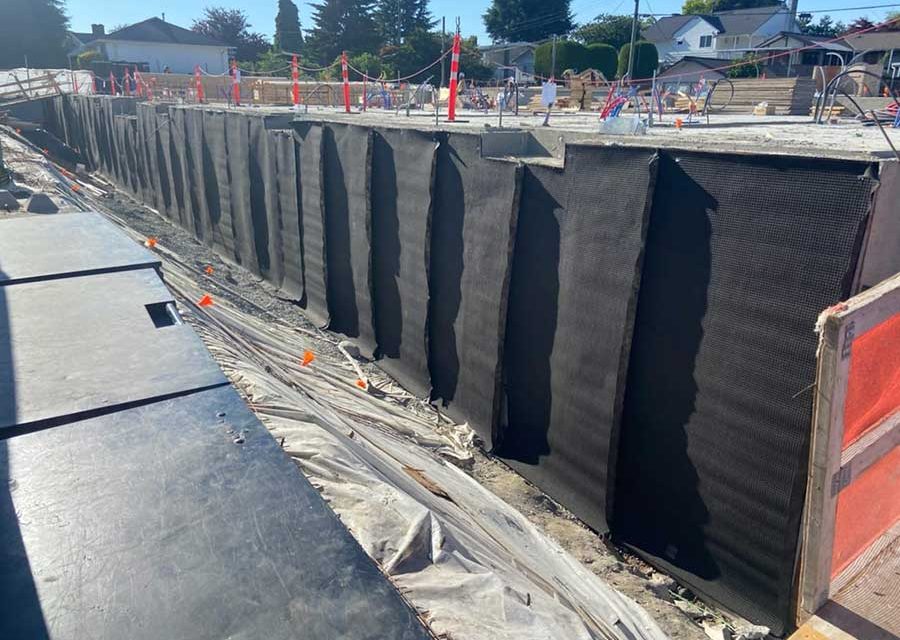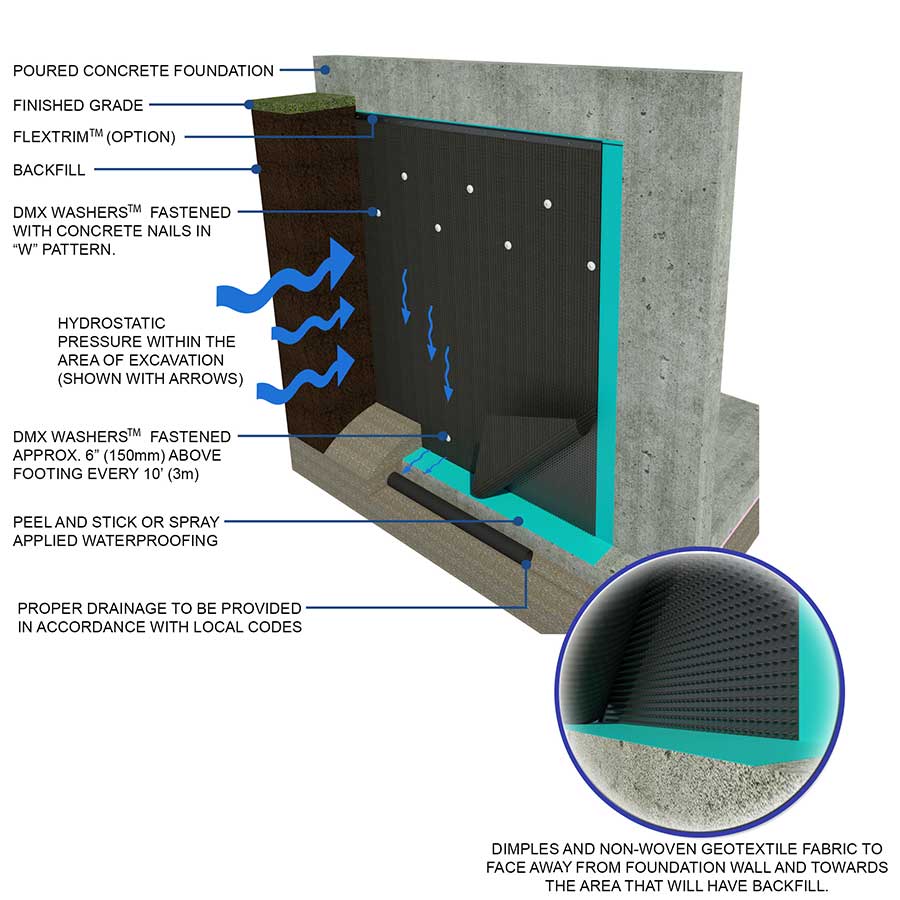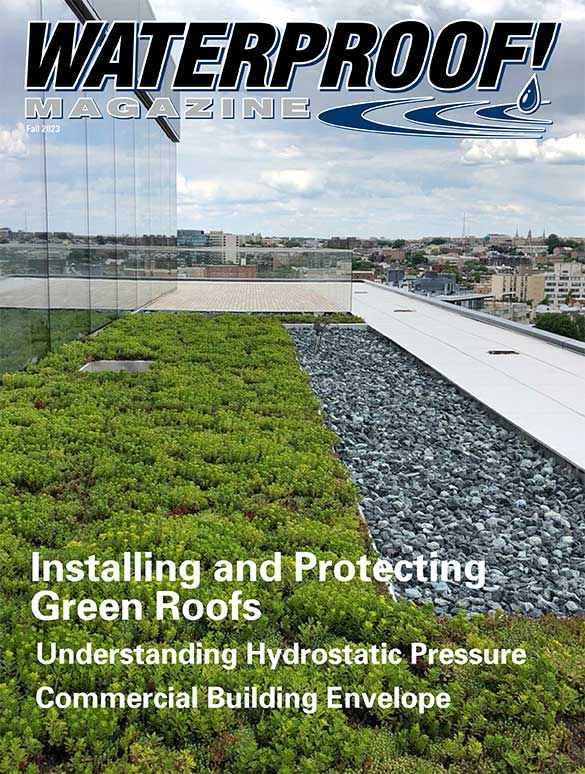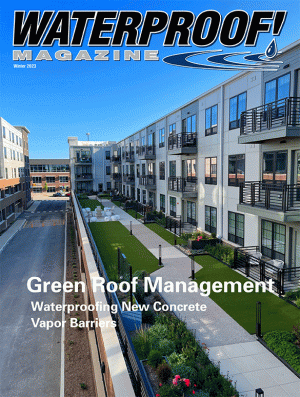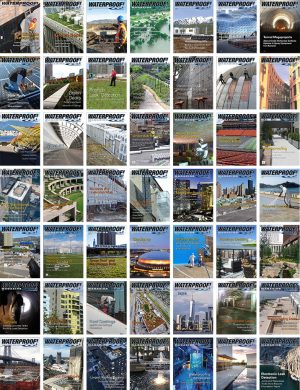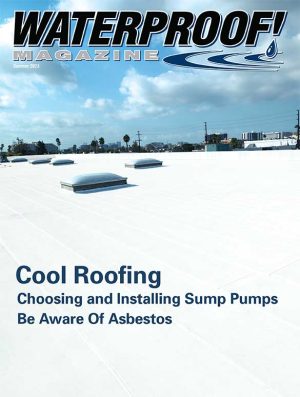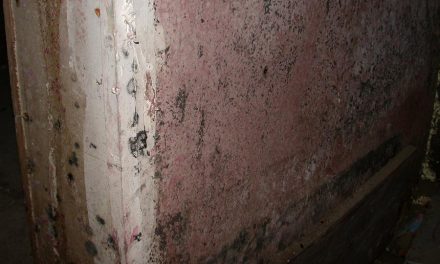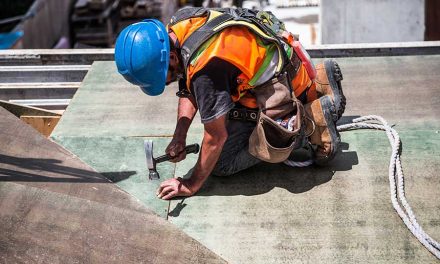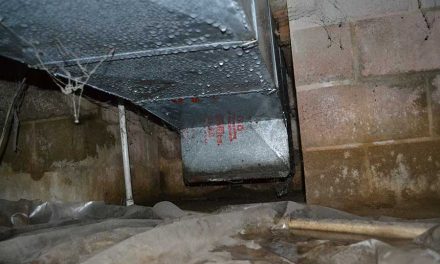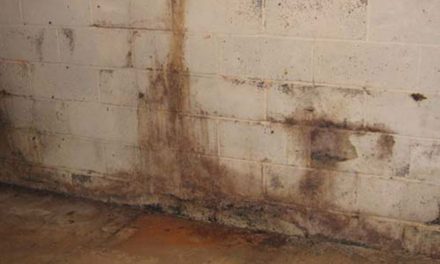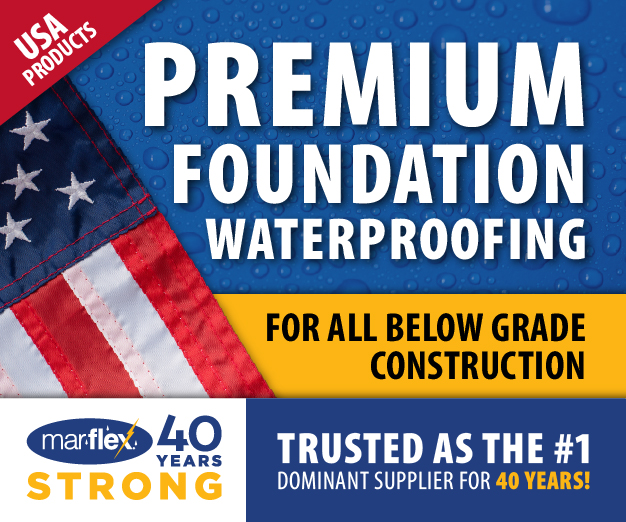By Vanessa Salvia
The filter fabric heat bonded to the dimples faces towards the backfill to promote drainage and reduce hydrostatic pressure on the foundation wall.
Hydrostatic pressure is an important topic for waterproofing professionals to understand. Hydrostatic pressure refers to the lateral pressure exerted by a fluid, and in the waterproofing world that typically means water, against a surface due to the weight and force of the fluid. Hydrostatic pressure increases with depth, so deeper water exerts higher hydrostatic pressure. Groundwater and rising floodwaters can create substantial hydrostatic pressures on foundations and below-grade walls and surfaces.
Cory Deyell, sales representative for DMX Membranes Limited, says hydrostatic pressure in soil refers to the pressure exerted by water within the soil pores due to the force of gravity. “It is a significant factor in geotechnical engineering and soil mechanics, as it affects the stability and behavior of soil masses,” he says.
When water accumulates and cannot drain properly, hydrostatic pressure builds up and pushes against the waterproofing membrane or material. This can lead to leaks if the pressure exceeds the membrane strength. A good way to visualize the force that a foundation must be able to endure from hydrostatic pressure is to think about the inverse of a swimming pool — swimming pool walls must withstand the lateral hydrostatic pressure of the large volume of water in the pool. In a similar way, anything below ground must be able to withstand the pressure of the water from the outside.
Anything below ground, such as foundations, basements, parking garages, below-grade rooms, elevator pits, etc., are vulnerable to hydrostatic pressure and require waterproofing designed to withstand the pressure. Proper drainage, such as drainage boards and perforated pipe, helps relieve hydrostatic pressure by giving water a path to drain away from the structure.
“When soil contains water, the water molecules fill the spaces between soil particles, creating a network of interconnected pores,” Dyell says. “The weight of the water in the pores, combined with the force of gravity acting on it, results in hydrostatic pressure. This pressure increases with depth in the soil profile.”
Causes of Hydrostatic Pressure
The main causes of hydrostatic pressure stem from situations that allow water to accumulate and press laterally against the structure because it has no way to drain or disperse properly. This is typically caused by a high groundwater table. As the water table rises, the hydrostatic pressure from this groundwater increases.
“The water table represents the upper boundary of the saturated zone, where the soil is fully saturated with water,” explains Deyell. “Below the water table, the hydrostatic pressure increases linearly with depth.”
Heavy rainfall or flooding can also increase this tendency because prolonged rain can overwhelm drainage systems, leading to water accumulation and increased lateral pressure. When there is improper or poor drainage for whatever reason, pressure also increases. Often, this is from improperly graded soil and or clogged drains that don’t allow water to move through and away.
The water doesn’t always have to come from the environment. A leak from pipes, pools, or water features, leaks from indoor plumbing, outdoor irrigation, or other water sources in the building environment can be a source of excess water that causes hydrostatic pressure that must be managed.
Effects of Hydrostatic Pressure
“Hydrostatic pressure affects the stability of slopes, retaining walls, and foundations,” says Deyell. “It can cause seepage and water flow through the soil, leading to erosion, piping, or even landslides. In geotechnical engineering, the estimation and analysis of hydrostatic pressure are crucial in designing structures to ensure their stability and prevent failures caused by excessive water pressure.”
Hydrostatic pressure can have several effects on a concrete foundation, depending on the specific conditions and design of the foundation. It can crush objects, it can cause objects to float, or it can cause objects to sink. Dyell outlines some of the effects of hydrostatic pressure:
Upward Pressure
If the groundwater level rises above the bottom of the foundation, hydrostatic pressure can exert an upward force on the foundation. This upward pressure can cause the foundation to lift or heave, leading to cracks, uneven settlement, or even structural damage.
Buoyancy
In cases where the groundwater level is high and the soil beneath the foundation is less dense than water, the hydrostatic pressure can cause the foundation to float or become partially buoyant. This can result in the foundation being displaced or uplifted, leading to structural instability.
Soil Erosion
Hydrostatic pressure can induce water flow through the soil and create erosion. If water seeps through the foundation or accumulates around it, it can wash away the supporting soil or weaken the foundation’s subsoil. This erosion can compromise the stability and integrity of the foundation.
Cracking and Leaking
Excessive hydrostatic pressure against the foundation walls or basement can lead to cracking or leakage issues. The pressure can push water through cracks or weak points in the concrete, causing water intrusion and potential water damage to the structure.
Differential Settlement
Hydrostatic pressure imbalances can cause differential settlement, where different parts of the foundation settle unevenly. This can lead to structural distortions, cracks, and other stability problems.
Magnitude of Hydrostatic Pressure
Hydrostatic pressure is an important factor that engineers consider when making design calculations and assessments, because it influences the stability of slopes and excavation walls. Additionally, properly accounting for hydrostatic pressures is crucial when designing drainage systems around structures and in civil engineering projects. Engineers use techniques like soil permeability testing and groundwater monitoring to evaluate hydrostatic pressures within the soil and groundwater profile at a site. These assessments of hydrostatic pressure help engineers understand the water pressures that will act on structures and inform appropriate designs to withstand or relieve these pressures.
“The magnitude of hydrostatic pressure depends on various factors, including the height of the water table or groundwater level, the specific weight of water, and the density and porosity of the soil,” says Deyell.
Overall, analyzing and accounting for hydrostatic pressures is key for engineers across many disciplines to create stable infrastructure, robust foundations and excavations, and effective drainage systems.
Mitigating the Effects
Matt Veazey, president of Rubber Polymer Corp., explains that water needs a way to move away from the building so the pressure doesn’t build up. “Water is going to take the path of least resistance,” Veazey says. “Let’s say you have no functioning drain tile, with water against the wall. That’s a mighty force that could crack that wall, seep into that wall, or if there is already a crack, it will find a way into your dwelling.”
When it comes to mitigating the effects of hydrostatic pressure on concrete foundations, several measures can be taken. One of the most important is installing an effective drainage system, including high flow rate drainage boards like the ones that DMX manufactures, proper surface grading, gutters, downspouts, and a French drain or weeping tile system, to control the water flow around the foundation.
Deyell recommends using a purpose-built drainage board with sufficient compressive strength and flow rate. 100% virgin resin ensures product longevity and performance. “DMX Drain 5X is a great example of this for residential/light commercial foundations,” he says. Additionally, waterproofing the foundation walls and using appropriate sealants to prevent water infiltration is key.
“Drainage boards provide six main benefits that aid in reducing hydrostatic pressure,” says Deyell. “Those benefits are water diversion, vertical water movement, horizontal water movement, water collection and channeling drainage into the French drain or weeping tile system, and protection of waterproofing systems.”
Understanding Head Pressure
Veazey says that a functioning drain is key to any waterproofing system or warranty. “That alleviates that head pressure because the free flowing water moving away from the structure doesn’t build up pressure.”
Water head pressure refers to the pressure exerted by a column of water due to the weight and force of gravity. It is directly related to the height of the water column. The taller the column of water, the greater the water head pressure at the bottom of the column. This is because there is more water weight pressing down from above. For example, a 10-foot-tall column of water would exert more pressure at the base than a 5-foot column.
This pressure is calculated by multiplying the height of the water column (in feet) by 0.433 to get the pressure in pounds per square inch (psi). So a water column 10 feet high produces a pressure of 4.33 psi at the base. While waterproofers could perform these calculations, most of the time they wouldn’t need to as long as there is a functioning drain. They can also look at the specifications of the materials they are using. Veazey’s Rub-R-Wall all-polymer spray-on waterproofing coating holds back 138 feet of head pressure. “That’s more than enough for a typical situation,” says Veazey.
The Bottom Line
Hydrostatic pressure can be an issue from groundwater as well as from water leaking from plumbing, pools, outdoor irrigation, or other water sources in the building environment.
Drainage boards are a necessary product to deal with hydrostatic head pressure below grade. Properly managing lateral water force through design and drainage will ensure structures remain protected.
Fall 2023 Back Issue
$4.95 – $5.95
AI in the Waterproofing Industry
Case Study: Northwestern University’s Simpson Querrey Biomedical Research Center
Installing and Protecting Green Roofs
Protecting the Commercial Building Envelope
Understanding Hydrostatic Pressure
Employer Responsibilities To Employees and Law
By Gregory Fahrenbruch
Description
Description
AI in the Waterproofing Industry
By Vanessa Salvia
It may be something you have to get used to, but once you do, it could be extremely useful and valuable.
Case Study: Northwestern University’s Simpson Querrey Biomedical Research Center
By American Hydrotech
The building’s proximity to Lake Michigan creates a high water table issue for the building.
Installing and Protecting Green Roofs
By Vanessa Salvia
There are many benefits of green roofs. However, successfully installing and maintaining a green roof requires careful planning and protection to ensure the plants thrive.
Protecting the Commercial Building Envelope
By Vanessa Salvia
Envelope performance directly impacts occupant comfort, health, energy efficiency, durability, and operating costs.
Understanding Hydrostatic Pressure
By Vanessa Salvia
When water accumulates and cannot drain properly, hydrostatic pressure builds up and pushes against the waterproofing membrane or material.
Employer Responsibilities To Employees and Law
By Gregory Fahrenbruch
Employers responsible for asbestos-related issues differ from those who do not work with asbestos but may have a potential for exposure to those who work abating asbestos products.
Additional Info
Additional information
| Weight | N/A |
|---|---|
| Magazine Format | Digital Download Magazine, Print Mailed Magazine |

